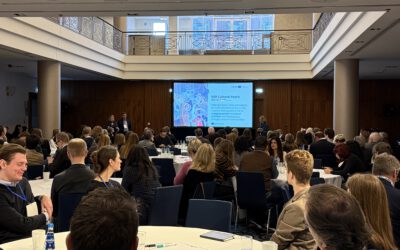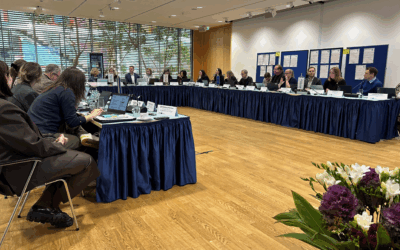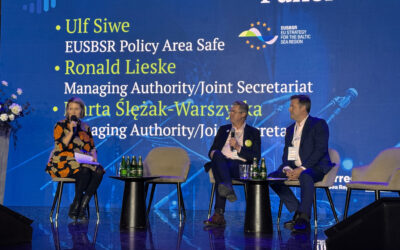
4 September 2023
Interreg helps advance the macro-region. A Baltic Sea region example.
Written by Elena Kolosova and Anna Gałyga
Why play alone if we can play together? We are #StrongerTogether after all! Interreg Baltic Sea Region has witnessed the growth of the first EU macro-regional strategy, EU Strategy for the Baltic Sea Region. Over a decade later, the region and its people benefit from a strong and unique partnership between the Strategy and the Programme.
In cooperation we believe!
Sharing the geographical area obliges. Both the Programme and the Strategy work to make the Baltic Sea region green, resilient and innovative. In a macro-regional dimension, the Strategy strives to save the Baltic Sea, connect the region and increase prosperity. These objectives outline the most important actions for 14 thematic policy areas. And this is when the Programme comes into play. It provides funding for fresh ideas that connect different organisations across borders and helps them implement projects across topics relevant to the Strategy.
Interreg Baltic Sea Region brings a lot of added value and impacts to people on the ground. It is a bright example of bringing the EU closer to the citizens, increasing solidarity and prosperity, says Anna Hagström from the Prime Minister’s Office in Sweden, Presidency of the EU Strategy for the Baltic Sea Region between July 2022 and June 2023
Since the adoption of the EU Strategy in 2009, more than 200 Interreg Baltic Sea Region projects have been helping in the implementation of the Strategy’s action plan.
Our Programme has been one of the main instruments to turn the will of political leaders into practice. Thanks to Interreg funding, cooperation in the Baltic Sea macro-region has improved across borders, sectors and governance levels. The Programme helped implement the action plan and fuelled the management of the Strategy itself. By using the resources smartly, we prove how efficient the Interreg funds are, explains Ronald Lieske, Director of the Managing Authority/Joint Secretariat of Interreg Baltic Sea Region.
So, what does the cooperation between the Programme and the Strategy look like?
Learn and connect! Interreg project developers link to macro-regional strategy.
Connecting a project idea to the needs of the region and anchoring them in regional strategies boosts visibility and connects the project to public administrations and thematic experts in the macro-region. No wonder that Interreg project developers seize the opportunity: “Briefing with the EUSBSR policy area coordinators opened eyes on the real will of cooperation,” as an applicant highlighted (source: a survey carried out by the MA/JS).
Interreg Baltic Sea Region 2021-2027 helps applicants better understand the EU Strategy for the Baltic Sea Region and its framework that drives the development of the region across the policy areas. At multiple events, applicants get to know the Strategy, selected actions and the coordinators driving the policy areas. Policy area coordinators also provide feedback on project ideas and discuss how they can support the implementation of projects from the beginning.
Implement together! New Interreg projects help implement the EUSBSR action plan.
The new funding period has brought promising results on the Strategy and Programme cooperation! All of the 85 new projects have a clear vision of how their activities help implement the actions of the EUSBSR policy areas. In practice, more than 800 project partner organisations from all the countries around the Baltic Sea work to bring their ideas into practice. They bring new solutions to shared challenges and new networks important for the region. This is how, in practical steps, they contribute to achieving objectives of the Strategy to increase prosperity, save the sea and connect the region. All in all, they will spend at least 150 million euros from the European Development Fund to advance the implementation of the EUSBSR action plan. And even more projects with more funds will come later in the Programme implementation.
Interreg Baltic Sea Region is a powerful tool which, through various types of projects, contributes to the achievement of the goals of the EU Strategy for the Baltic Sea Region, says Elīna Veidemane, coordinator of the EUSBSR policy area Spatial Planning, on the results of the first calls for applications in the new Interreg Baltic Sea Region 2021-2027.
Engage and share! The EUSBR helps make the projects and their results more visible.
The EUSBSR offers its framework to help projects succeed. The coordinators of the policy areas bring thematically connected projects together and connect them to their steering groups consisting of representatives of the national or regional governments of the EUSBSR Member States and Norway. They also help communicate the projects’ solutions and results to thematic networks in the Baltic Sea region and other EU macro-regions.
PA Innovation supports the projects during their implementation in the transfer of solutions in the EUSBSR and BSR networks and to other EU macro-regional strategies, as well as through policy dialogue with the PA Innovation steering group, macro-regional events in the BSR and the EU. PA Innovation also contributes to project events, and explores synergies and exchange opportunities between the projects and other related BSR/EUSBSR projects and projects under other EU macro-regional strategies, explains Esa Kokkonen, coordinator of the EUSBSR policy area Innovation, the Baltic Institute of Finland.
Use Interreg project results! How projects drive the implementation of the EUSBSR action plan.
The report of the European Commission on the implementation of the EU macro-regional strategies in 2022 brought a few examples how Interreg Baltic Sea Region projects helped implement the EUSBSR action plan. In the policy area Energy, the Interreg project Baltic InteGrid developed a professional network and provided fora for expertise exchange and interdisciplinary research on the optimisation of offshore wind energy. The project BEST helped the policy area Nutri tackle both eutrophication and risks posed by hazardous substances by improving industrial sewage treatment in the Baltic Sea region. The project ECOPRODIGI and its follow-up EXOPRODIGI helped the policy area Ship increase eco-efficiency in the maritime sector in the Baltic Sea by creating and piloting digital solutions developed jointly by industry end-users and research organisations.
Results matter even more when they are used after the projects’ completion. Building on some 100 projects from Interreg and other EU funding programmes, project platforms, implemented in 2018-2021, triggered important policy changes. For example, BSR WATER and SuMaNu platforms with the coordinators of the policy areas Nutri, Bioeconomy and Hazards helped develop HELCOM’s new Baltic Sea Regional Nutrient Recycling Strategy. Together, they advanced the “Save the Sea” objective of the Strategy. The Capacity4MSP platform, led by the coordinator of the policy area Spatial Planning, helped shape the Regional Maritime Spatial Planning Roadmap 2021-2030. The Roadmap was adopted by HELCOM and VASAB and contributed to the Strategy’s objective “Connect the region”. The CAMS platform with the coordinator of the policy area Energy developed policy recommendations on how to integrate climate change considerations into the new European Structural and Investment Funds programmes 2021-2027. Together, they helped come closer to the Strategy’s objective “Connect the region” in terms of the efficiency and security of energy markets. The Blue Platform together with the coordinators of the policy areas Bioeconomy and Innovation developed a roadmap that drives the development of the blue bioeconomy in the region beyond 2021, and helps reach progress in the Strategy’s objective “Increase prosperity”.
Interreg Baltic Sea Region will continue its support to project platforms in the period of 2021-2027. Once there is a good number of projects and their results in place, new project platforms will be launched. This will be another opportunity to advance the implementation of the Strategy’s action plan.
Cooperate and stay together!
The benefits of advancing the EUSBSR action plan and providing the projects with a macro-regional dimension are obvious. In addition, it is important to highlight the working level of the partnership of the Programme and the EUSBSR. Bilateral meetings between the EUSBSR policy area coordinators and the Managing Authority/Joint Secretariat of Interreg Baltic Sea Region, as well as mutual contributions to each other’s events, are more a rule than an exception. Thanks to this, policy area coordinators can act as Interreg ambassadors as they understand the opportunities created by funding for transnational cooperation. The Programme, on the other hand, can better support projects in tuning in to the Strategy objectives.
As, at the end of the day, it is about the project results and how they change the life of the people around the Baltic Sea. The cooperation between the Programme and the Strategy simply brings these changes to another level.
More recent news
Designing Interreg Baltic Sea Region that belongs to everyone
10 December 2025 Designing Interreg Baltic Sea Region that belongs to everyone Written by Eeva Rantama What if the next Interreg Baltic Sea Region...
Monitoring the Programme’s progress: transnational cooperation in the making
Representatives from nine Programme area countries gathered in Berlin on 19-20 November 2025 to review the progress of the Programme’s implementation and start preparing for the post-2027 period.
Beyond Borders: Turning Interreg Results into Policy Action
At this year’s EUSBSR Annual Forum in Sopot, the session “Beyond Borders: Interreg Results in Action for a Resilient and Safe Baltic Sea Region” showcased how Interreg Baltic Sea Region projects are transforming challenges into policy-relevant results that strengthen resilience, safety, and cooperation across the region. The session brought together project partners, EUSBSR policy area coordinators, members of the Programme Monitoring Committee and young participants to explore what it takes to turn project outcomes into lasting policy impact.
How territorial cooperation builds us a home: the Baltic Sea region example
A room full of people waving their green and orange cards, prominent panelists on stage, and a clear hero of the day: territorial cooperation, making the Baltic Sea region feel like home. The joint session during this year’s EU Week of Regions and Cities was filled with positive energy, commitment and hopes for the future. What stood out most?






